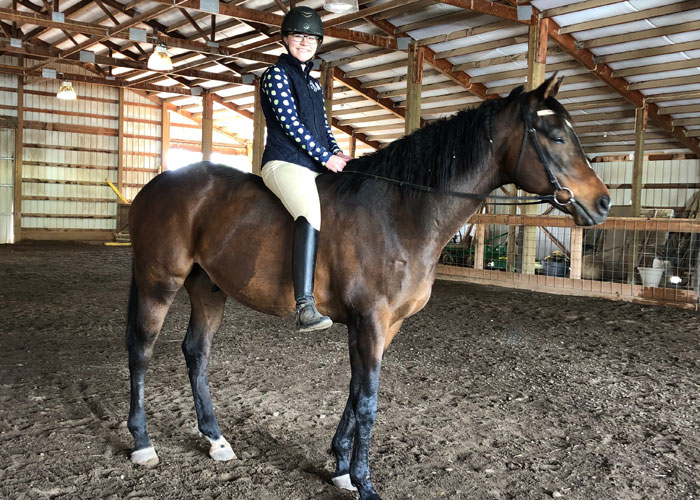- Home
- Patient Stories
- Hip Dysplasia - Lydia Druin
Hip Dysplasia - Lydia Druin

In January of 2017, Lydia Druin was training to qualify for a prestigious dressage competition. Dressage is an equestrian sport where riders compete to showcase the natural athleticism and grace of the horse. Lydia’s qualification for the competition was exciting; she had been riding her whole life and had been training to qualify for a year. However, Lydia’s constant hip pain was becoming increasingly worse. Her condition deteriorated so rapidly that by March she was not even able to ride, or compete, and had to stop to training altogether.
Lydia recalls it began when she was in the eighth grade and running cross country. She noticed pain in her hips, lower back and lower legs. She eventually had to quit cross country, and by the time she was in the 9th grade, she was not able to participate in any school sports; the only activity she was able to participate in was horseback riding.
She started seeing a chiropractor to help with mobility. She was told her hips were in such bad shape she would probably need a hip replacement before she was 20 years old. After three years of weekly appointments, Lydia says she was frustrated with not having any answers or improvement and decided to try a new chiropractor.
After the first appointment with the new chiropractor, she was told that at 18 she should not be experiencing this level of pain and they would figure out what was going on. She had been seeing the new chiropractor for three months when she was forced to cease training for the upcoming summer of showing. She was referred to Cecilia Pascual-Garrido, MD, PhD, a member of the Adolescent and Young Adult Hip Disorders Center at Washington University Orthopedics.
On May 19, 2017, Lydia finally had a diagnosis. She had bilateral hip dysplasia. Her right hip had a labrum tear secondary to hip dysplasia.
Dr. Pascual-Garrido says, “Hip dysplasia is a common cause of hip pain in the young adult female. These patients are normally females (80%) and present bilateral hip dysplasia (80%). Before, these patients were treated for chronic pain for many years and unfortunately progressed to arthritis where a total hip replacement was the only solution for them. Today with the progress in hip joint preservation, we are able to offer joint preservation procedures that allow our patients to maintain their own joint and maintain a high level of activity following the procedure. We have improved remarkably not only in the treatment but also in the diagnosis. We have new imaging modality technology such as CT with 3D that allow us to better understand the abnormal hip morphology that needs to be treated. Additionally, a high percent of these patients present labral tears secondary to chronic instability. Currently, we have refined the surgical technique. We perform a mini approach to the hip to perform the osteotomy and correct the instability. Additionally, we can treat the torn labrum with a concomitant hip arthroscopy.”
Lydia says, “It was such a relief to hear I didn’t need a hip replacement but it could be fixed. There was an actual problem and it was not all in my head. Dr. Pascual-Garrido has been so proactive. I appreciate that she took me seriously.”
Her first of two surgeries was scheduled one month following her diagnosis — and almost two months before she left home for college at the University of Idaho.
“I was a little worried about living on my own after just having surgery. The University of Idaho is a walking only campus. But the disability services on campus have been amazing. I was able to arrange to be picked up and dropped off to class.”
Dr. Pascual-Garrido says, “The outcomes for this surgery are predictable in institutions with a high volume. We are currently having very successful outcomes with 92% survival rate at 15 years. This is tremendous improvement when we compare outcomes to those from 10 years ago with survival rates of only 60% and conversion rates to THR of 34%. Also, complication rates have reduced significantly with 5% of complications. However, it is important that the patients understand that this surgery is complex and is technically challenging. Patients will need to commit to the recovery. Patients normally stay in the hospital between 2-3 days and have a recovery time of 4-6 months.”
Lydia’s surgery went very well. Within six months of surgery she was back to riding.
“Living with chronic pain you don’t realize how much pain you have until it’s no longer there. Before the surgery there were several things I couldn’t do on the horses, even before my pain increased in 2017. Now I can do everything without pain.”
Lydia spent her entire summer horseback riding and exploring new trails in Shawnee National Forest in southern Illinois.
She is majoring in Ecology/Conservation Biology and Wildlife resource. She has always been interested in endangered species and predators. “I really want to work on endangered predator conservation.” It’s a job that can require up 20 miles worth of hiking and field work in a day.
Most of Lydia’s research is focused on Sitka black-tailed deer in southeastern Alaska. This last summer, Lydia went to Alaska. “I did fieldwork for a week and studied habitat selection of Sitka black-tailed deer and their population genetics and my hip held up great.”
“I appreciate how Dr. Pascual-Garrido took me seriously and was able to find the cause of my problem. I would have never been able to pursue my dreams as an ecologist without having this surgery.”
More Info: